Russia, China, Iran exploit George Floyd protests in U.S.
Government officials, politicians, and state media
Russia, China, Iran exploit George Floyd protests in U.S.
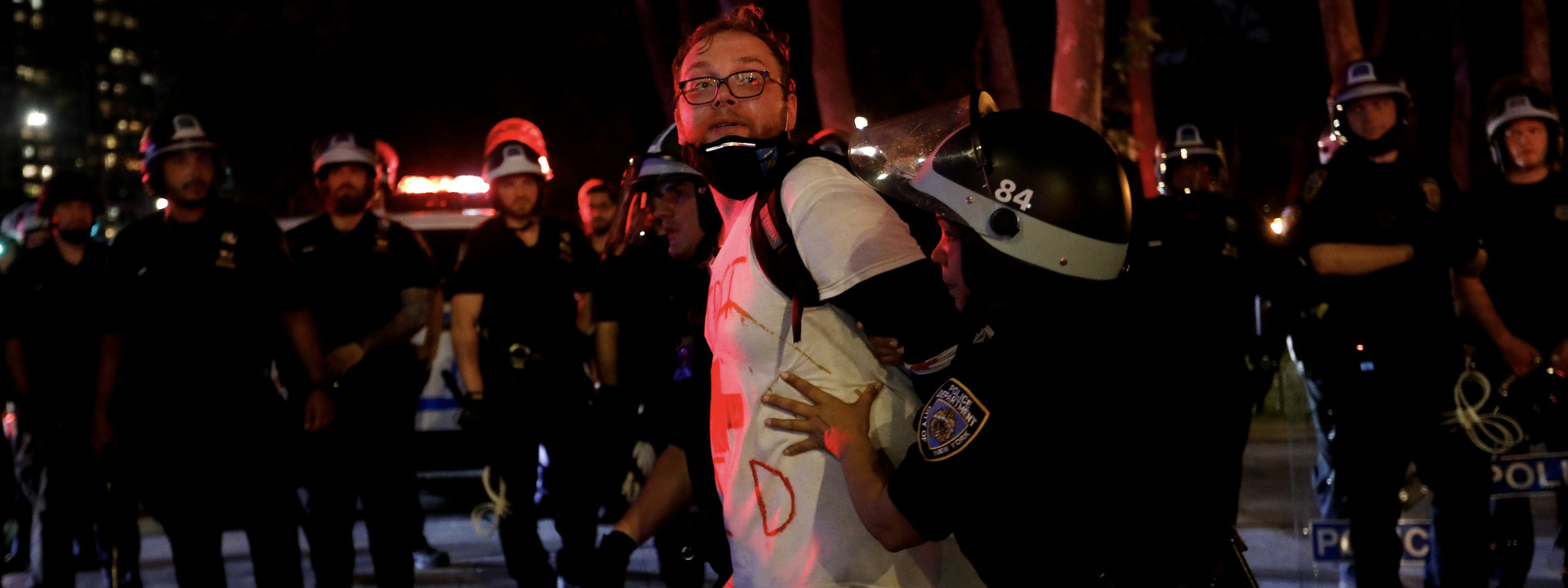
Government officials, politicians, and state media take to social media to call out U.S. hypocrisy around the George Floyd protests

Note: This piece contains disturbing images of George Floyd’s death.
Russian, Chinese, and Iranian propagandists have been quick to capitalize on U.S. protests following the May 25 killing of unarmed African American man George Floyd by Minneapolis police. Between May 25 and June 3, roughly 27,000 Russian, Chinese, and Farsi articles were published on Floyd’s death and the resultant U.S. national outcry. This steady stream of government statements and state-adjacent media stories targeting domestic audiences is being used to advance broader foreign policy objectives.
Russia, China and Iran have all previously accused the United States of interfering in their internal affairs. The DFRLab previously reported on Russia’s unsubstantiated allegations that the United States incited and orchestrated Moscow protests in 2019. Meanwhile, Beijing sees Washington’s support of Hong Kong’s pro-democracy movement as a clear violation of national sovereignty. Iran has gone so far as to claim that its deadly 2019 protests were the product of a conspiracy headed by the United States. Much of the foreign rhetoric around the death of George Floyd has focused on chiding the United States for these purported actions.
While unanimous in their criticism of the United States, Chinese, Russian, and Iranian propaganda each demonstrate different narrative styles. Kremlin actors try to portray the U.S. as a hypocritical power, one that exports freely stoked “color revolutions” in nations of the former Soviet bloc and that now desperately seeks to avoid a revolution at home. China has used U.S. protests, including the current ones, to reinforce its argument that other countries should not criticize Beijing’s suppression of the pro-democracy movement in Hong Kong. Iranian authorities emphasize racial discrimination and use of force by U.S. police while seeking to discredit international criticisms of their own violent crackdown on protests in late 2019.
According to analysis performed using the social media monitoring service Meltwater Explore, the name “George Floyd” appeared in roughly 20,000 Mandarin Chinese-language news articles between May 25 and June 3, approximately 4,600 Farsi-language articles, and around 1,500 Russian-language ones.
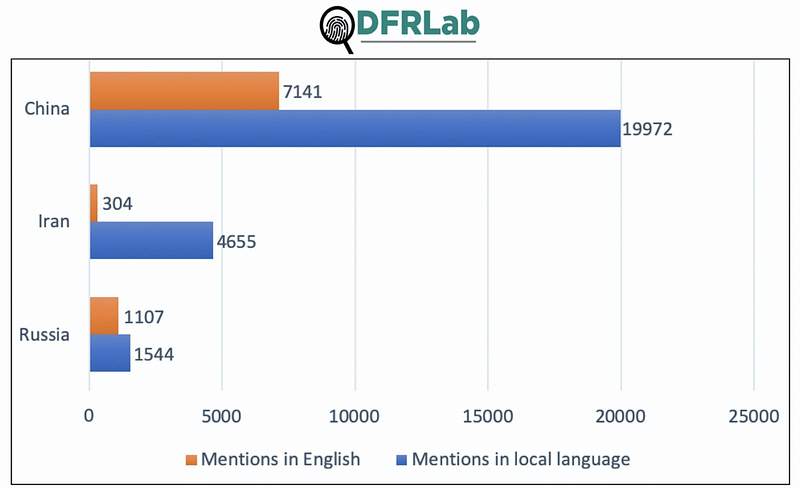
Ultimately, each U.S. adversary seeks to leverage the death of George Floyd toward its own ends, striking back and widening domestic U.S. divisions in order to deter future U.S. foreign policy actions.
Russia anticipates “color revolution” in the United States
Although U.S. officials have warned that the Kremlin might use current developments to amplify division and sow racial discord within American society, so far there is no definitive evidence that Russian actors are undertaking a covert social media campaign to aggravate existing racial unrest. Nevertheless, Kremlin actors are enthusiastic to talk about the current protests as evidence of a systemic crisis and share their insight with their domestic audiences.
Russian politicians, in turn, have drawn multiple parallels between the U.S. protests and “colorful revolutions” in other countries, accusing the U.S. Democratic Party of triggering unrest to overthrow President Donald Trump. Aleksey Zhuaravlyov, a member of Russia’s State Duma, expressed his excitement at seeing the U.S. embroiled in massive protests; he was among those to level the charge of the Democrats using the protests to overthrow Trump, implying that it was no coincidence that many protests were taking place in heavily Democratic states.
Kremlin actors are also eloquent while talking about the use of police force against protesters. Igor Morozov, deputy chair of the Federation Council Committee on Science, Education, and Culture, claimed that police aggression toward protesters is understandable as these are the same policemen who have trained partisans in civil wars in Iraq, Syria, and Libya, among other locations. Vladimir Zhirinovsky, leader of the Liberal Democratic Party of Russia, added that the U.S. is on the verge of revolution and that Russia should send its own National Guard to the U.S. to protect citizens from violence.
Similar to Russian politicians, Kremlin-funded media actively pushed narratives about the “colorful revolution” danger for the United States. RT, for instance, referred to the protests as a “historical justice” that Washington, having sought to carry out a “controlled chaos” strategy in former Soviet countries, may now experience it as well. Margarita Simonyan, RT’s editor-in-chief, asserted that the U.S. will eventually interfere in domestic affairs of other countries even more aggressively, because such interference brings huge economic benefits for the U.S. and that the country will need to divert attention from its internal problems. Another Kremlin-funded TV channel, Rossiya 24, called the U.S. protests “street wars” and presented abusive treatment of black people as a normal and acceptable U.S. government practice. Finally, Kremlin propagandist Dmitry Kiselev showcased an image on his TV show that showed the Statue of Liberty kneeling on George Floyd’s neck.

China exploits U.S. unrest to justify Hong Kong crackdown
Beijing has used the U.S. protests to defend its suppression of the pro-democracy movement in Hong Kong. Chinese officials criticized the U.S. government mainly for its handling of current unrest while expressing some sympathy for protesters.
Chinese officials also tried to troll the U.S. government amid the ongoing protests. Hua Chunying, a spokesperson for the Chinese Minstry of Foreign Affairs (MFA), tweeted “I can’t breathe” alongside a screenshot of a tweet posted by the U.S. State Department spokeperson Morgan Ortagus expressing concerns over the protests in Hong Kong. Zhao Lijian, another Chinese MFA spokesperson, urged the U.S. to put an end to racial discrimination and to protect minorities in the country. Carrie Lam, Chief Executive of Hong Kong, accused the U.S. of “double standards” and asserted both that Hong Kong police handled the protests in that city much better and that the U.S. has no basis for criticizing the Hong Kong authorities after witnessing how U.S. police are handling the current protests.
Chinese state-owned media also tried to exploit unrest in the United States and condemned Washington’s reproach of Beijing’s crackdown on Hong Kong’s anti-government protests. Hu Xijin, editor-in-chief of Chinese state-owned outlet Global Times, suggested that a protester from Hong Kong had infiltrated the U.S. and masterminded violent demonstrations across the country. In his article, Hu also asserted, “[T]he U.S. political system is declining… while the U.S. showed no strength to carry out substantial reforms.” Global Times also tweeted a widely seen video depicting New York Police Department vehicles driving into people with the accompanying text, “Peacekeepers or mass murderers?”
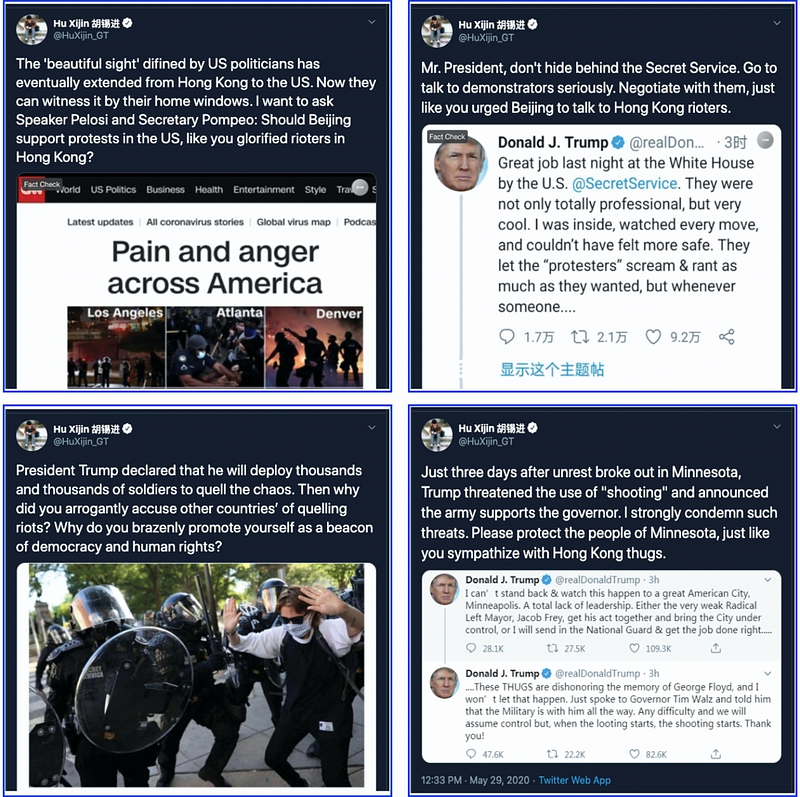
Chinese propaganda outlets amplified photos and videos showing violence by protesters, burning buildings, and excessive use of force by the police. People’s Daily, for example, posted a comparative video of U.S. and Hong Kong protests to its page on Weibo, the Chinese equivalent of Twitter. The video showed the arrest of CNN journalist Omar Jimenez during protests in Minneapolis and included a line of text saying “the video shows you who is brutal and unprofessional and who is professionally restrained,” and the hashtag #香港警有多克制# (“How restrained are the Hong Kong police”). The second video showed Hong Kong police officers surrounded by journalists in October 2019. The People’s Daily Weibo post garnered almost 135,000 positive reactions and nearly 7,000 shares within two days of its posting.
The DFRLab examined several other hashtags on Weibo related to protests in the United States and found that the aforementioned “How restrained are the Hong Kong police” garnered 300 million views as of June 2. Another hashtag, “the U.S. Riots,” amassed over 2 billion views by the same day. People’s Daily also launched a third hashtag, “U.S. National Guard opened fire at residential homes,” thought it had only garnered around 340 views as of June 2.
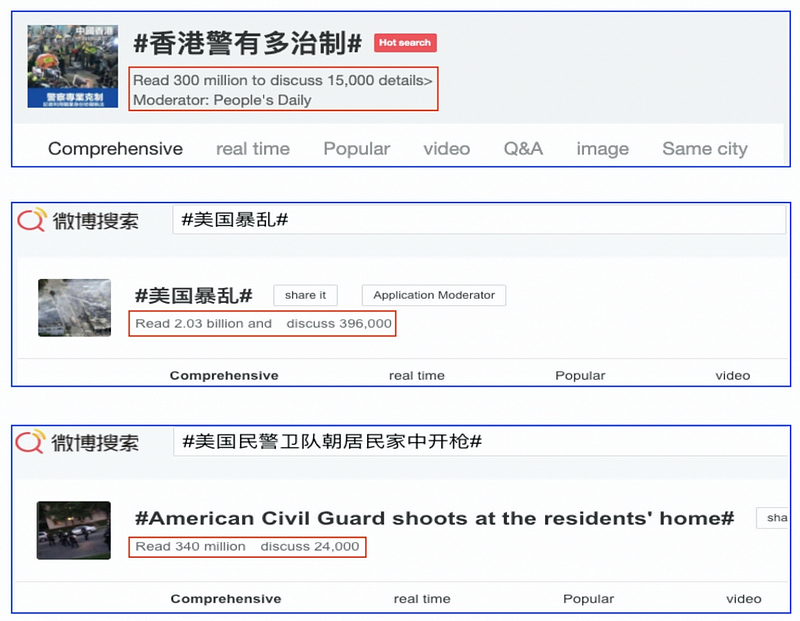
Even though China tried to depict the Hong Kong police as more tolerant, the available evidence suggested that they used harsh tactics during the 2019 protests, when they arrested thousands of protesters. The 2019 Hong Kong protests erupted after Chinese Communist Part proposed a bill allowing for the extradition of Hong Kong citizens to mainland China. This bill contained serious risks for Hong Kong’s judicial independence and would force its citizens into mainland China’s unfair judiciary system. In an attempt to crush Hong Kong’s autonomy, police used facial recognition technology to identify and trace Hong Kong protesters, fired tear gas inside subway stations and densely populated residential areas, shot rubber bullets at close range, and attacked journalists without provocation. Moreover, whereas Chinese officials have urged the United States to respect the rights of ethnic minorities, the Chinese Communist Party has locked up over 1 million Uighur Muslims in detention camps in northwestern China, mostly under the pretense of countering terrorism and Islamic extremism.
Interestingly enough, China and Russia also amplified each others’ narratives about the U.S. protests. China’s Xinhua News republished the Russian MFA statement about the U.S. police violence against journalists during demonstrations. Hua Chunying retweeted an RT video clip on her Twitter timeline, repeating the video’s chyron “THUGS&HEROES HYPOCRISY.” Conversely, in Russia, an RT journalist claimed the U.S. government called Hong Kong protesters freedom fighters while also calling the U.S. protesters thugs.
Iran reproaches the U.S. for discrimination and police brutality
In Iran, authorities have seized the opportunity to criticize the U.S. government. Although the Iranian government banned Twitter in 2009, various Iranian officials nevertheless use the platform to convey messages. On May 27, 2020, Iranian Supreme Leader Ayatollah Khamenei retweeted a video from his official website’s Twitter account, with its accompanying text, “If you’re dark-skinned walking in the U.S., you can’t be sure you’ll be alive in the next few minutes.”
Similar to Chinese leaders, Iranian authorities also attempted to troll the Trump administration. Iranian foreign minister Javad Zarif tweeted an edited text of a statement from U.S. Secretary of State Mike Pompeo in which the word “Iran” was replaced with “America” throughout the text. Pompeo’s original letter was released in 2018 and highlighted U.S. concerns over undemocratic practices of the Iranian government. Zarif also reproached Europe for being silent about ongoing “brutality against protesters & and press” in the United States and blamed Washington for using a “knee-on-neck technique” against 80 million Iranians over the last two years.
Some don't think #BlackLivesMatter.
To those of us who do: it is long overdue for the entire world to wage war against racism.
Time for a #WorldAgainstRacism. pic.twitter.com/06p1LmmwgF
— Javad Zarif (@JZarif) May 30, 2020
On May 29, Iran’s foreign ministry condemned the “deadly racial discrimination in the United States” and reaffirmed that “the voices of the protesters must be heard.” Along similar lines, ministry spokesperson Abbas Mousavi accused the U.S. government of “glorifying systematic racism and white supremacism” and urged it to “stop oppression of its people.”
Multiple Iranian accounts also tweeted the same image comparing two photos: one showing Minneapolis police officer Derek Chauvin kneeling on the neck of George Floyd, and the other depicting Iran’s supreme leader kissing an African student’s hand in 2013. The accounts posting this image mostly argued that Islam is more tolerant than Western civilization; that Islam respects human rights more than Western societies; and that Western culture is about discrimination and racism whereas Islam is about brotherhood and equality.
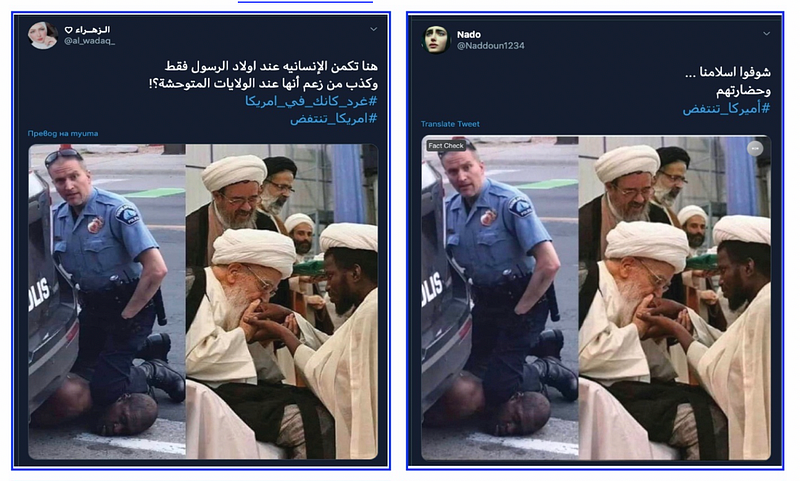
Iran’s criticism of the U.S. government for “brutal suppression of protests” serves to divert attention away from the country’s own human rights violations and the November 2019 crackdown on protests, which had arisen after the government reduced fuel subsidies. Although Iranian officials recently claimed that only 230 people were killed during the protests, Amnesty International released details of at least 304 deaths, and one Iranian opposition website says that at least 631 people had been killed. Meanwhile, Iranian authorities do not allow local media to cover protests freely, often threatening to charge them with crimes.
Russia, China, and Iran clearly see the current unrest in the United States as an opportunity to promote their interests. The use of excessive force to suppress protests following the killing of George Floyd is a particular opportunity for these countries to point the finger at the hypocrisy of the United States, reproaching it for condemning harsh repression of protests in their countries while undertaking similar techniques at home. In the end, the U.S. protests are an ideal opportunity to divert attention away from each respective country’s internal problems.
Givi Gigitashvili is Research Assistant, Caucasus, with the Digital Forensic Research Lab.
Follow along on Twitter for more in-depth analysis from our #DigitalSherlocks.

